|

Our
Former Home: an Ancient Capital in Central China (top page)
Xi'an is a former capital with a rich
history and growing contemporary importance. It was also our home from
August 2002 to August 2005. |
|
("Up" takes you to the Photo Album
index)
Sub-pages:
   
|
|
(▲ Links to this page's sub-pages. If you can't see the label, put your mouse over a
button and look at the bottom of your browser.) |

The area has been China's capital several
times, starting in about 200 BC. During the Tang dynasty (particularly
from AD 618 to the late 700s), this city (then called Chang An) was
probably the largest and most prosperous city in the world. As the
starting place for the Silk Road, the city has long been a center for the
exchange of both goods and ideas between East and West.
From the 6000-year-old ruins unearthed nearby, to dozens of tombs left by
the many dynasties that had capitals here, Xi'an has provided important
clues into China's past. With over 6.5 million people and the continual
construction found in all of China's cities, Xi'an has plenty of dust and
pollution--which have been hard on our health--but the city also has a lot
going for it, both in terms of history and as the "door" to China's
vast central and western regions.

Michael first visited Xi'an with his parents
in the late 1980s, and it
had certainly changed by the time Vivian and Andrew first saw it in 2000! The
above photo
shows the nearby mountains, looking south from our apartment roof.
Click here to read a student's overview of
Xi'an. |
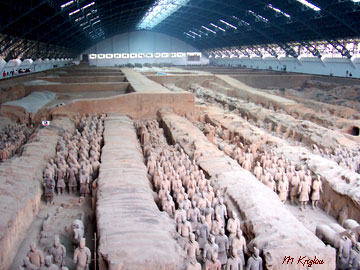 |
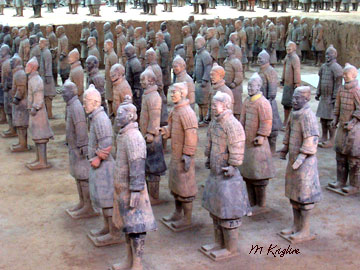 |
|
To the outside world, Xi'an is most famous for
the nearby Terra-cotta army of China's "first emperor," Qin Shi-huang. He
was certainly one of history's most ambitious leaders, for he is credited
with unifying various warring kingdoms, constructing the Great Wall,
building the largest palace in the ancient world, and creating this tomb
containing thousands of life-size soldiers to guard him in "the next
life." The exquisite clay army lay silent in their underground formation
from 200 BC until 1974 when several farmers discovered them by accident.
In addition to the clay soldiers and horses, two bronze chariots were also
buried (below left). This is a UNESCO world-heritage site, and Chinese
officials are to be commended for their work in patiently unearthing and
reconstructing the figures, and carefully protecting one of the most
important archeological discoveries of all time. I'm also glad that the
ban on taking photos had been lifted before our 2005 visit! |
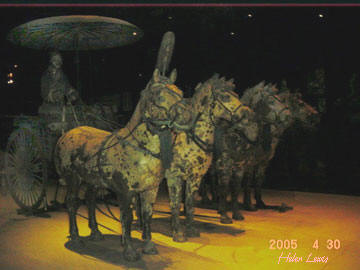 |
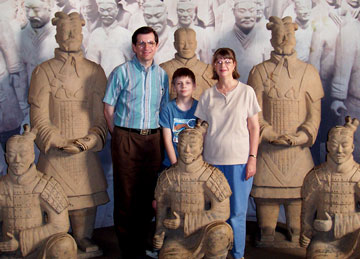 |
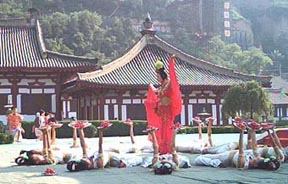
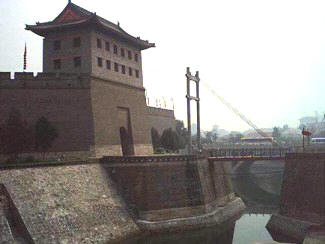 |
(left) An ancient dance
sees new life at Huaqing Palace, one of several important historical sites
not far from the Terra-cotta army
(below left) Xi'an still has a huge wall going all the way
around the city (it's one of the best-preserved city walls in the world).
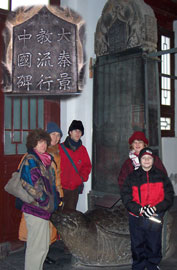
(above) Just before Christmas 2004 we visited the oldest museum
in China (the Forest of Steles in Xi'an). The Nestorian tablet, seen here,
dates back to the mid to late 700s (AD) and gives important details about some of the earliest
Christians who had a positive relationship with China's leaders (Xi'an was
the capital back then). The tablet lay buried for 1000 years before
being found in the 1600s. Click here for related
photos/info. |
|
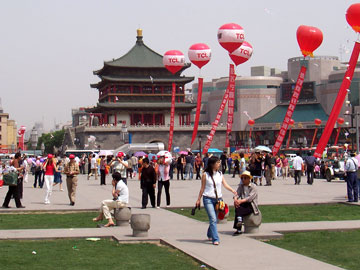
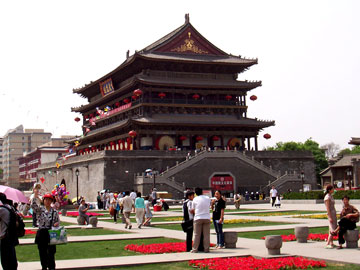
(left) This
Bell Tower has served in central Xi'an since the 1300s. Across the pubic
square, you'll find the
Drum Tower (right). Both buildings were renovated while we lived here, as
the public and private sector work to make the downtown area a beautiful
place to shop or visit. Xi'an has several shopping centers, including the
one seen behind the Bell Tower, and an upscale shopping mall UNDER
this square! |
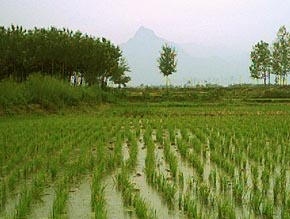
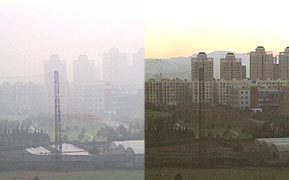
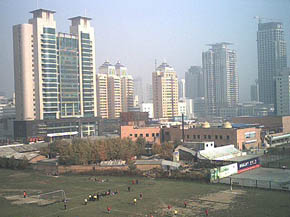
The first photo was taken on the outskirts of town. The
photo on the right was taken, looking
northeast from our apartment roof into the High Tech Zone. The center view
(actually the same view shot twice) was also taken from our apartment
roof, looking south toward the mountains we could see about six times a year. Normally we
could barely see the buildings (much less the distant mountains) through the haze
and pollution (as shown). This pollution gave us bronchitis and eventually
pneumonia, and was the main reason we had to leave the city.
In addition to
its famous terra-cotta army, Xi'an also has many other ancient tombs,
palaces and temples. It has one of the best history
museums in China, a wonderful bird park, and beautiful natural
areas in the nearby mountains. It's really a great place to visit! |

Click in the boxes below to go to some of our most popular pages. If
you get lost, just click "Home."
See our
Policy
regarding the use of materials available at Krigline.com or
Krigline.com.cn |












